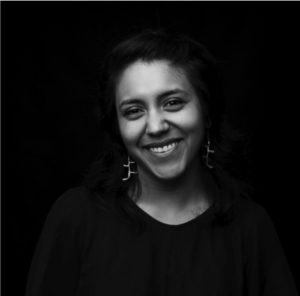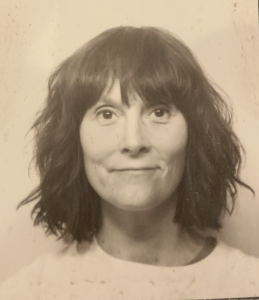Curationist in Conversation: CARLA AMAYA & VIRGINIA POUNDSTONE
Meet two more contributors who help make Curationist a reality:


What brought you to Curationist? What is your engagement with it?
Virginia Poundstone – I came to Curationist through Garrett Graddy-Lovelace. She was a former MHz Foundation board member and is now a consultant for academic partnerships. When she was a board member, she described the nascent Foundation and the preliminary idea of curating Creative Commons and public domain art and culture content. Immediately my brain started lighting up; my synapses were on fire. Our conversation turned into a brainstorm. When the position of Content Curation Director came up, I applied and was thrilled to go through the full interview process with all the various stakeholders. I was able to propose some of my preliminary ideas and get everyone excited. That’s how I got here.
Now, as the Content Curation Director, I’m the sole full-time employee on the project which means I’m very multimodal. I designed, and continue to iterate on, the overall vision for the project as a whole, in collaboration with all the stakeholders, my team of Digital Curators, Advising Editors, and Contributors as well as the Director of Communications and Strategic Partnerships, Marketing and Promotions Specialist, Executive Director and the Board of Directors. I also do a lot of planning and thinking about our digital products that will support the work of digital curation. That means I work with the Technical Project Manager, visual designers, and developers, to think through our next stages that will make our tools more expansive and interactive, so the site becomes a living hub, not just something to passively view. I manage and direct a team of extremely talented moonlighting freelancers, from a diverse array of not only cultural backgrounds, but creative backgrounds. Carla, for example, is an architect by training. Sonja is a designer, Bomin is an artist, Kimi is in graduate school earning an MFA and is focused on cultural organizing, installation, and publishing, Valentina is a textile artist, and Amber is in television and film production, and has also done curation on Central American diasporas. We have this really amazing diverse team that I have the great pleasure of working with, and giving direction to.
Carla Amaya – I heard about Curationist through Valentina Cabezas, who is a Contributor on the content curation team. We originally met in Baltimore through a project of hers, and then we kept in touch once I moved to Paris to pursue a Master’s Degree. I am still in Paris where I am finishing my research and working. Aside from my formal studies, I’ve always found a way to engage in non-profit missions outside of an architectural context. Around the same time that Valentina had told me about Curationist, she also informed me about a position opening up. I was looking for some project coordination experience, so I applied. I read further about Curationist and its mission, and I felt like it was a cause I didn’t want to miss out on. I also knew that my formal background could be an added perspective. Now I am working closely with Virginia in coordinating logistics for the content curation team.
Would you say there’s a difference between “just Googling” something to find an answer and truly understanding a topic?
CA – I think that the processes are similar in, you know, choosing a topic, sifting through massive amounts of information, then making your own conclusion based on what you find. But, I think wanting to truly understand a topic comes from how much you pay attention, and how selective you are of what you’re confronted with. Ultimately, I think it’s about the quality of the information that you choose; making sure that what you’re reading is reliable and thorough.
VP – Yeah, that’s such a tricky thing to do in our digital era, isn’t it? It’s hard to know who to trust when everything is at our fingertips. As an artist and an educator, a big part of my background is around both learning how to understand things myself for my various projects, and then also learning how to teach, or share knowledge. I think when you Google something, you get a lightning bolt, but you have no idea what that lightning bolt is, you don’t know where it came from, it’s like a pre-Ben Franklin moment. You have just a glimpse into something, but you don’t know what it is, where it comes from, or how it works. To try to understand something, it’s multi-layered, you have to experience it and your understanding evolves over time. You hear something new, and then you have to touch it, and then you have to smell it, and then you can start to understand what it is. It’s multi-sensory. I really feel like you have to be able to deep dive into things, in order to begin to understand something. Everything is constantly shifting and evolving, which is exciting, but because of this evolution, I don’t think you can ever truly understand something. All we can really do is acknowledge the limits of our knowledge, and do the best that we can by continually learning more.
When was a time when someone’s introduction to a subject or unique perspective made you more interested in it?
CA – So, recently I was having a discussion with a professor on what a safe space really means, specifically in the context of being queer. A question I had posed to him was whether or not architects are responsible for reversing the unwelcoming factors of existing spaces to make them safer or more welcoming. In that discussion, he had made a point about making a distinction between queer space and queered space. Essentially, queer space is a space that’s occupied by a queer and marginalized people already, while the queered space is one that is a reaction to the status quo. So, it’s kind of like a queer space would be an art gallery that displays LGBTQ artists and a queered space would be exclusive to that community. And so queered space proposes more of a conscious act of resistance. I found the semantics of that really made me think about how careful we have to be when describing an intention. Now I think I’m just a little more mindful of that when I’m doing research on the subject and mindful of my keywords and how I approach each topic.
VP – That’s so interesting. It makes me think about the new rehang of MoMA’s collection. It feels queered-informed, which is an enormous stretch of the meaning of queering something or challenging heteronormativity, so stay with me – I might be wrong. As you walk down 53rd Street in midtown Manhattan, toward the Museum of Modern Art entrance, you can see parts of the collection from the street, you don’t have to go in. You can see art from the street. For free! That is a massive shift from their entire history. It’s already visible and you don’t have to pay the $25 to go in and see it. If you want to see the full collection you do have to shell out the money, but there’s something that’s available to everyone even before you enter. Inside, they took down the hierarchies of the taxonomy and categories between the curatorial departments: Design, Architecture, Drawing and Prints, Painting and Sculpture, Film, Photography, Media and Performance, Publications, Video (Digital Media) are hung together instead of separately, as they used to be. This leveling of the playing field between mediums is what I meant when I said queered-informed. By challenging the superiority of the church of Painting and Sculpture, a much more interesting and rich experience, by understanding where our modern and contemporary culture begins to form.
The Internet is a global phenomenon, and yet much of the content is from a Global North (aka Global Minority) perspective. Why do you think it’s important to include different perspectives?
VP – Because it elevates everybody so much. Because we don’t know what we don’t know. For example, I’m looking through the Smithsonian Open Access Collection right now. It’s the 100th year of women’s suffrage here in the US, so I started looking at ‘family’ as a keyword. I wanted to see what was in the collection and what family structure has looked like over time, according to what is available through open access. I found a lot of traditional portraits. Among them were an abundance of George Washington’s family. One in particular included an enslaved person standing to the side without identification. It’s important that if I make a collection and include those portraits that there is also a family portrait that represents a family of enslaved people, so that we can begin to see a bigger picture and understand American history in the larger context. Otherwise, if I had just shown the George Washington family portrait, you know, as the founding father and everything is perfect about this person, and continued to omit his visible but unacknowledged identity as an enslaver, we lose a key understanding of our culture. But if you take a bigger lens, and you can see various families, not just a black family and a white family, enslaved or enslaver, but also all of the indigenous families and immigrant families that have made up America; you begin to understand what family actually is and means. You start to look at your own culture possibly differently because now, you have more information to think about and process. It’s fascinating what can get uncovered.
CA – Just to touch on that, the whole idea of reflection is so important and the way it makes you reflect on your background, where you’ve come from. I think it also allows us to build bridges of communication, you know, real or virtual; opening up dialogue for deeper connections of sorts, or understanding.
We have access to an almost incomprehensible number of cultural works. Do you think there’s still a value to providing context and commentary alongside this content?
VP – Yes! The way that archives are made is under structures of white supremacy. Meaning, it is a hierarchical system and process of externally naming from the outside. Categorization is based on colonial dominance, most of the categorization for cultural heritage is in the English language for example. One of the most standard vocabularies for cultural heritage comes from the Getty Research Institute. It doesn’t have a word for piñata, ‘vessel’ is as close as you can get; there’s a clear difference between a piñata and a vessel, but the taxonomy doesn’t have room for expansive lexicons. Now because of brilliant scholarly work that has critiqued these systems, the Getty Vocabularies are working with linked open data, to move towards a structure that is inclusive and ever-evolving.
CA – I was thinking of it simply in the context of our project where we’re working on the standard of content for us and for Curationist. And understanding that we need different perspectives because I think that imagery alone has the ability to be misinterpreted. To better understand the information, we need to be able to provide as much context and commentary as possible.
Given the context of what and where Curationist is today, what are your hopes for Curationist in the future?
VP – I hope that it is a place where people feel really welcomed, have fun, and want to be a part of it, in community. I think we can build something that people want to contribute to, add their knowledge to, and to feel valued within. People who are cultural producers, cultural thinkers, people who are just enthusiastic about the arts – I hope that we become a place where they can find things and participate in knowledge-making as part of a joyful, open collective.
Curationist is one website with multiple views.